|
Strategic Alliances –
Part two
Compoundings Magazine
November, 2001
By Thomas F. Glenn, Petroleum Trends International, Inc.
and Kevin J. Fiala, Bywater Corporate Development

This two-part article, written by PetroTrends
and its alliance partner Bywater Corporate Development Services,
provides information on what alliances are and how independent lubricant
manufacturers can use them to grow their businesses. Part I, appearing
in the October issue of Compoundings, focused on the concepts of
alliances. Part II bring the issue home, and speaks directly to
how independent lubricant manufacturers can make alliances work
for them.
As discussed in Part I in this
series on alliances, the lubricants business has changed significantly
over the last decade and more change is on the way. These changes
have and will continue to present both challenges and business opportunities
for independent lubricant manufactures. Strategic alliances provide
independents with a flexible, relatively low risk and cost effective
strategy to use in pursuit of some of the business opportunities
in today’s market.
Two of the most common reasons
for forming alliances are to accelerate growth and to gain access
to core capabilities. They offer particularly
attractive solutions to independent lubricant manufactures when
there are strategic gaps in critical differential capabilities that
are too expensive or will take too long to develop internally. The
following represent just some of the alliances that have been consummated
and/or explored by independent lubricant manufactures:
Lube manufacturer
with filter manufacturer to fill product gap – A lube manufacturer
has established a strategic alliance with a filter paper manufacturer
to better serve its industrial customers. By providing a product
that can be customized to suit its customers’ specific needs,
the lube manufacturer establishes a differentiator and another way
to keep competition out.
Lubricant manufacturer with
another lube manufacturer to fill geographic gap
– Given the competitive nature among many of the independent
lube manufactures, there are a limited number of examples of two
blenders partnering. However, there are cases where two manufacturers
from different geographical areas partner to bid on a larger regional
account.
Lubricant manufacturer with
environmental clean-up company to fill service gap
– Working in conjunction with its alliance partner, a lubricant
manufacturer can offer waste oil disposal and hazardous chemical
clean-up services to its customers.
Lube manufacture with another
lubricant manufactures to fill product gap
– Brand XYZ distributor has a customer that wants ABC’s
brand of oil. In these cases, XYZ distributor can partner with an
ABC brand distributor, typically out of XYZ’s geographic market,
to fill the customer’s need. These alliances typically involve
synthetic lubricants and other specialty lubricant products.
Lube manufacturer with a lubricant
distributor – Lubricant distributor
interested in reducing its dependence on a consolidating pool of
major suppliers allies with an independent lubricant manufacture
to obtain a private label product. The independent benefits from
the business and may have an opportunity to the leverage distributor’s
distribution network.
Lube manufacturer with an equipment
management company – An independent
lube manufacturer forms an alliance with an equipment management
company in an effort to leverage its access to channels and its
customer’s reliance on them for product recommendation. In
return, the equipment management company benefits from the lube
manufacturer’s expertise, product development and trouble shooting
capabilities.
Lube manufacturer with an original
equipment manufacturer (OEM) – Alliance can assist equipment
owners optimize component life and machine uptime. Typically includes
predictive and preventive maintenance programs, technical service,
fluid management and other lubricant and engineering related services
offered jointly by the OEM and lube supplier.
In addition to the types of alliances
highlighted above, alliancing opportunities exist in:
• Packaging
• Laboratory services
• Toll manufacturing
• Chemical management
• Cleaning products and other lubricant related products
• Transportation management
• International trade partners
Now that we have highlighted just
some of the destinations alliances can take us. The next questions
is what is the best way to get there and how?
OVERVIEW OF APPROACH TO ALLIANCING
Past experience suggest that the
journey of alliancing must begin with a clear business need for
all parties, that a set of shared goals and shared values must be
agreed upon, that an integrated planning process is employed, all
of which is underpinned by a common measures model. These concepts
are the foundation of the PetroTrends-Bywater approach to establishing
winning alliances that deliver step changes in performance. Figure
1 provides an overview of our Five-Step approach. A sampling of
key activities in each Step of our alliancing process is revived
in the remainder of this article.
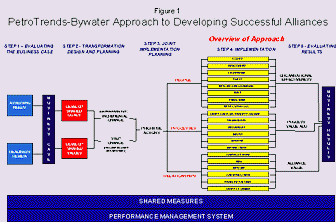
STEP 1: EVALUATING THE BUSINESS CASE
In the 1990’s, General Motors
Corporation made headlines by demanding double-digit price cuts,
breaking long-term contracts and sharing information with rivals
in a quest for lower bids. It focused on price alone with its suppliers
– it ignored total costs. In the end, GM polarized its suppliers
and lost market share.
Companies so often claim to want to get closer to their suppliers
and customers, but when asked if they’ll share information
or amend their strategy, they say that they cannot trust the other
party in doing that. This is especially true when the potential
alliance partner is also a competitor, as is the case with many
ILMA members. (Note that an estimated 50% of alliances in existence
today are between competitors.) The difficulty of marrying two corporate
cultures has even led one U.S. corporation to amend its policy:
‘We don’t do alliancing any more – we never get the
benefits we know are there. If they’re strategic we buy them.’
Summary of key activities in Step
1:
• Clarify the compelling business
need for developing an alliance partnership.
• Assess how the project or
contract fits with potential alliance partner’s strategies.
• Assess the prevailing cultural
norms and operating style of potential alliance partners –
cultural profiling (see Figure 2).
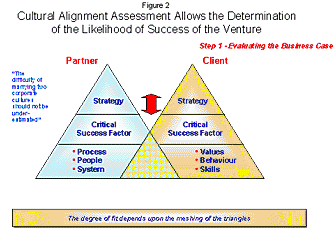
• Select partner or partners
STEPS 2 & 3: TRANSFORMATION DESIGN AND
PLANNING & JOINT IMPLEMENTATION PLANNING
If where you are trying to get
to with the alliance is clear – the shared goals – the
planning is the task of saying what you will do to get you there.
It has two elements:
• Known Problems (Incremental
Change): Involves listing down all the known areas of difficulty
or problem, and then defining what would be needed by all parties
to put these problems right.
• Unconstrained Opportunities (Step-Changes): Like the supplier
who says he’ll move his factory and put it next to the customer.
Or the customer that bases his QA staff at the supplier’s factory.
Or where R&D of the two firms is merged together.
What is important about the planning
process is that it is open, done jointly, and that known problems
and unconstrained opportunities are discussed separately. If not,
the debate quickly reverts to the known, rather than searching for
the greater potential that is the unknown.
But what type of improvements are
we talking about? The types of areas that need to be reviewed in
the planning process are shown in Figure 3.
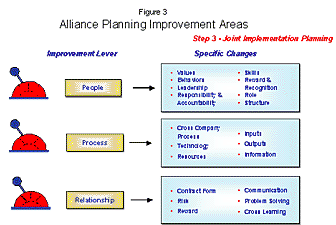
Alliancing, like any change program, needs early
wins to provide confidence to both parties that this was a good
route to go down. As shown in Figure 4, prioritizing the opportunities
identified by the planning process, and then using that as the basis
to set out a joint action plan ensures some of the “low hanging
fruit” is picked first, before setting off up Mount Everest
together.
Summary of key activities in Step 3:
• Develop a common vision built upon the
individual aspirations of each alliance partner and upon shared
goals and values.
• Assess gaps in the cultural profiles,
performance standards, values and behavioural norms that need to
be addressed.
• Develop clear performance targets for
the project or contract and commit to actions.
• Translate stretch targets into a series
of detailed plans.
• Develop joint organization structures
for the project or contract and plans to deliver the targets.
• Develop joint delivery processes.
• Agree risk and reward structure and the
relationship management process.
• Develop a series of shard performance
measure and a common measurement system.
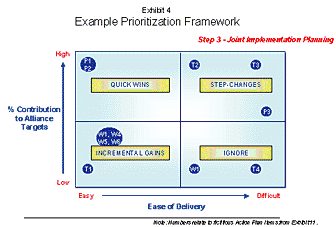
STEPS 4 & 5: IMPLEMENTATION & EVALUATING
RESULTS
If measures are the glue that holds organizations
together, then their importance when dealing with multiple companies
is even greater. If shared goals, values and actions have been agreed,
the only way to keep the alliance on track is to measure progress
towards them. However, the construction of a measures model for
an alliance is subtly different to that of a company. The purpose
of a particular alliance tends to be far more focused than that
of a company. Where a Balanced Scorecard approach is extremely useful
for firms, it can lose the overriding strategic imperative in an
alliance.
Take an R&D alliance in the aerospace industry.
It exists to design a new plane within a certain cost and timeframe.
Another example is a topside alliance in the oil industry. Its primary
aim is maximum production (topside efficiency) for minimum operating
cost. That’s it. The operator of that oil platform may have
many other considerations. And they have the whole asset to think
about, not just topside. But for the alliance, it is those two strategic
measures that matter.
Therefore, we have found that a cascade measures
model driven from the two or three strategic measures defining the
purpose of the alliance is most effective, as shown in Figure 5.
Lower level measures, which link root-cause elements to the strategic
goals are then the order of the day. But keeping the whole thing
simple and focused is the absolute key to success. As is, of course,
all parties viewing those measures in the same way from the same
data.
Summary of key activities in Steps 4 &
5:
• Install the common measurement system.
• Follow up on key personnel to ensure
data is routinely gathered to populate the common measurement system.
• Monitor progress and effectiveness of
implementation plans.
• Conduct regular performance reviews against
the targets to drive out improvement actions.
• Develop an effective and practical process
for capturing lessons learned and concluding key phases of the project
or contract.
• Enable constructive feedback and sharing
of the learning amongst the alliance partners.
• Implement facilitated assessments with
each participant.
• Employ joint workshop with both departing
and remaining partners.
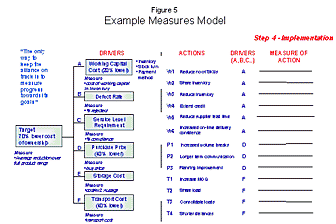
LESSONS LEARNED
Based on past assignments and research conducted
by PetroTrends and Bywater’s on alliancing, we have summarized
some of our key learnings below. The learnings are segmented into
five categories and each of these categories is plotted by “Difficulty
to Achieve” and “Importance to a Successful Alliance”
in Figure 6.
1. Business Need
• Identified as the most important pre-requisite
for a successful alliance.
• Tends to be a subjective debate amongst
participants.
2. Effective Measures
• Identified as the most difficult area.
• Must be clearly linked with the shared
goals and planning activities for the alliance.
• The cascaded measures model is far more
effective than the balanced score card approach.
3. Shared Values
• Identified as difficult to achieve but
not so important.
• Experience shows most failures occur
where values are miss-aligned.
4. Shared Goals
• Identified as a medium priority in the
importance matrix.
• Joint goal setting workshops with alliance
partners have been successful mechanism.
5. Clear Plan with Actions
• Leadership structure is important.
• Link between activities (making it happen)
and the plan is the most difficult area.
• Building trust between participants is
critical.
• Participants need a structure to openly
share known and historic problems.
• Participants bring baggage and need help
to leave it behind.
• Most participants are both unfamiliar
and uncomfortable with step change planning and need structure and
support.
• Forcing step change planning really tests
commitment to the business case.
• How to enable step-change planning when
most participants are grossly uncomfortable with it?
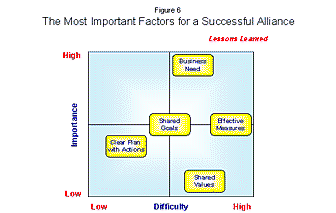
ALLIANCING CHECKLISTS
Whether you are about to embark, are on the
road, or just pulling in for your first pit stop, the critical factor
in alliancing is recognizing it is a journey, not a one off project.
And to embark on a journey, one must have a map, and have shown
it to fellow travelers. As with all journeys, you are never quite
sure what you will find along the way, even if you have a clear
view of where you are heading. That is why establishing mutual trust,
understanding and confidence with your fellow companions is key
before ever setting off. And if you do decide to set off, PetroTrends
and Bywater Corporate Development Services hope the planning checklists
below are helpful to you.
Choosing a Partner
• Is the proposed alliance activity or
process strategic in nature?
• Have you conducted a capability assessment of all potential
parties? Have you picked the winner?
• For your chosen partner, have both companies done a cultural
assessment to identify areas of difference?
• Is there a clearly identified business need for both parties?
• Has a business case been constructed which identifies the
benefits of the alliance?
• Do both parties have similar experiences of alliancing? Is
there a common level of maturity?
• Would you hire their managers to run your business?
Ready to Go?
• Do you have a set of shared goals?
• Do both parties have a common view of success and failure?
• Have you developed a statement of values which dictates how
you will work together?
• Is the measures model built?
• Have you agreed how you will report and review progress towards
these measures?
• Have you defined the organizational structure of the alliance?
• Have clear stretch targets been set which align to both companies’
corporate strategies?
• How would you rate the trust you have in your partner on
a scale of 1 to 10?
• Have you agreed how to share the losses if something goes
wrong?
On The Road
• Do you have a mechanism for escalating
problems which cannot be resolved within the operational alliance
structure?
• Are you focused on delivering some quick wins?
• Do individuals in both companies get rewarded on alliance
performance or parent company performance?
• Is there an effective communications process being used?
• Has integrated planning become the way of setting direction,
or do both firms plan separately?
• Are there clear milestones and objectives which are regularly
reviewed?
• Is there a mechanism for a pit-stop, i.e., a chance to stand
back, take stock, and then drive forward again?
Copyright © Petroleum Trends International,
Inc.- Bywater Alliance. 2002
|
